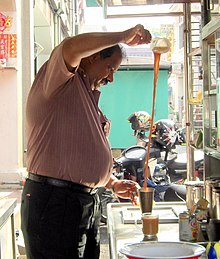Pouring
This may be done to move the contents to another container (such as pouring a shared drink from a bottle into individual cups), to coat a surface with the contents (as in pouring a syrup onto solid food, or the artistic technique of paint pouring), or simply to empty the original container.
[1] In contrast, in industrial processes such as casting where a molten metal is poured into a mould, the pouring process can induce the creation of bifilms (doubly-oxidated surfaces folded over on each other) which lead to further defects in the final cast part.
[2] The difficulty of controlling all the variables when pouring purely by hand, along with the potential danger to people in the vicinity from splashing of hot liquid, has led to the development of automated pouring equipment for use in industrial settings.
[4][5] Systems for pouring face unique difficulties compared to other cases of robots manipulating physical objects: contact sensors cannot be attached directly to liquids, so measuring parameters of pouring, such as vibration and the amount of liquid which has been poured, may require the use of computer vision techniques.
[6][7] The metaphor of "pouring prayers" appears in Sanskrit, Latin, and Ancient Greek poetry, in reference to the literal pouring out of a drink onto the ground or over an icon as an offering in a libation.

